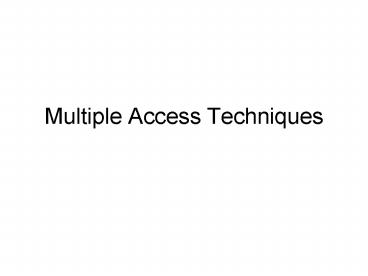Multiple Access Techniques - PowerPoint PPT Presentation
1 / 15
Title:
Multiple Access Techniques
Description:
FDD is suitable for radio communication systems, whereas TDD is ... overpower the base-station receiver by drowning out the signals of far away subscribers. ... – PowerPoint PPT presentation
Number of Views:194
Avg rating:3.0/5.0
Title: Multiple Access Techniques
1
Multiple Access Techniques
2
Duplexing
- Duplexing facilitates communications in both
directions simultaneously base station to mobile
and mobile to base station - Duplexing is done either using frequency or time
domain techniques - Frequency division duplexing (FDD)
- Time division duplexing (TDD)
- FDD is suitable for radio communication systems,
whereas TDD is more suitable for fixed wireless
systems
3
Multiple Access Techniques
- Frequency Division Multiple Access
- Time Division Multiple Access
- Spread Spectrum Multiple Access
- Space Division Multiple Access
- Packet Radio
4
Frequency Division Multiple Access (FDMA)
- The frequency spectrum is divided into unique
frequency bands or channels - These channels are assigned to users on demand
- Multiple users cannot share a channel
- Users are assigned a channel as a pair of
frequencies (forward and reverse channels) - FDMA requires tight RF filtering to reduce
adjacent channel interference
5
FDMA
TIME
Channel-2
Channel-3
Channel-6
Channel-4
Channel-5
Channel-7
Channel-8
Channel-9
FREQUENCY
6
Time Division Multiple Access (TDMA)
- TDMA systems divides the radio spectrum into time
slots, and in each time slot only one use is
allowed to either transmit or receive - Transmission for any user is non-continuous
- In each TDMA frame, the preamble contains the
address and synchronization information - TDMA shares a single carrier frequency with
several users - TDMA could allocate varied number of time slots
per frame to different users
7
TDMA
FREQUENCY
Channel-10
Channel-7
Channel-8
Channel-9
Channel-6
Channel-5
Channel-4
Channel-3
Channel-2
Channel-1
TIME
8
Spread Spectrum Multiple Access (SSMA)
- SSMA uses signals that have a transmission
bandwidth several orders of magnitude greater
than the minimum required RF bandwidth - SSMA provides immunity to multipath interference
and robust multiple access capability - SSMA is bandwidth efficient in multi-user
environment - SSMA techniques
- Frequency hopped (FH) multiple access
- Direct sequence (DS) multiple access
- Also known as code division multiple access
(CDMA)
9
FHMA
- Carrier frequencies of individual users are
varied in a pseudorandom fashion within a
wideband channel - Data of each user is broken into uniform size
bursts that are transmitted on different channels
at different time instants based on their
pseudo-noise (PN) code sequence - In the FH receiver, a locally generated PN code
is used to synchronize the receivers
instantaneous frequency with that of the
transmitter - FHMA provides inherent security, and guard
against erasures through error control coding and
interleaving - Use Bluetooth and HomeRF
10
CDMA
- The narrowband message signal is multiplied by a
very large bandwidth signal called spreading
signal - The spreading signal has a pseudo-noise code
sequence that has a chip rate which is orders of
magnitudes greater than the data rates of the
message - All users use the same carrier frequency and can
transmit simultaneously - Each use has its own pseudorandom codeword that
is orthogonal to the others - The receivers need to know the codeword of the
corresponding sender - Power control is used to combat the near-far
problem - Near-far problem
- When many mobile users share the same channel,
the strongest received mobile signal will capture
the demodulator at a base station. Thus a nearby
subscriber could overpower the base-station
receiver by drowning out the signals of far away
subscribers.
11
CDMA Features
- Many users of CDMA share the same frequency
either TDD or FDD may be used - CDMA has soft capacity limit system performance
is inversely proportional to the number of users - Multipath fading is reduced because of the signal
spread - Channel data rates are very high
- Prone to self-jamming and near-far problem
- Self-jamming when the spreading sequences of
different users are not exactly orthogonal - Near-far problem occurs at a CDMA receiver if an
undesired user has a high detected power compared
to the desired user
12
Space Division Multiple Access (SDMA)
- SDMA controls the radiated energy for each user
and serves different users by using spot beam
antennas - Different areas covered by antenna beam may be
served by same or different frequencies - Reverse links present difficulty
- Transmitted power from each subscriber must be
controlled to prevent any single user from
driving up the interference level - Transmit power is limited by battery consumption
at the subscriber unit
13
Packet Radio
- In Packet Radio (PR) access techniques, many
subscribers attempt to access a single channel in
an uncoordinated manner - Collisions from simultaneous transmissions from
multiple transmitters are detected at the base
station receiver, in which case an ACK or NACK
signal is broadcasted by the base station to
alert the user - PR subscribers use a contention technique to
transmit on a common channel
14
Packet Radio Protocols
- If a packet transmission duration is t, the time
duration during which it is susceptible to a
collision (vulnerable period) is t1 2t, where t1
is the transmission time instant - Throughput ltPrno collisions
- Contention protocols
- Random access
- Scheduled access
- Hybrid access
- ALOHA protocols pure and slotted
15
Carrier Sense Multiple Access Protocols (CSMA)
- In CSMA protocols, each terminal on the network
is able to monitor the status of the channel
before transmitting information - Variations
- 1-persistent CSMA
- non-persistent CSMA
- p-persistent CSMA
- CSMA/CD































